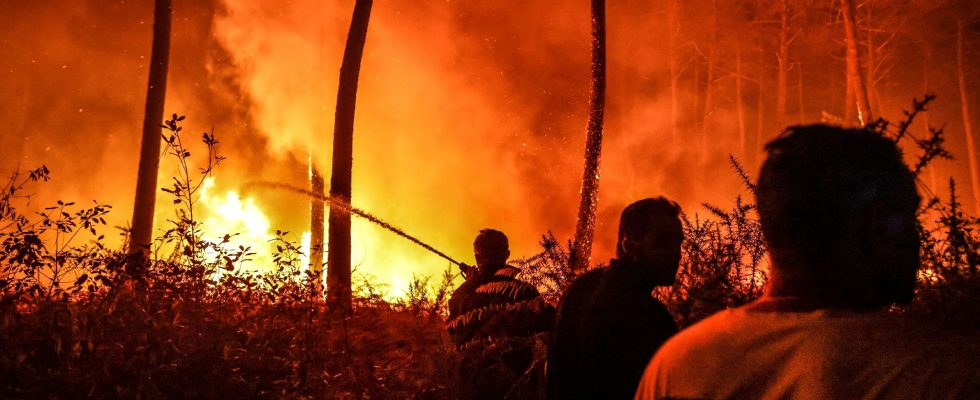Many climate indicators are changing from orange to red, announcing a summer 2023 potentially even hotter than that of 2022. According to the European meteorological service Copernicus, the average global temperatures recorded in early June are the hottest on record for this period. They have even already exceeded pre-industrial levels by more than 1.5°C between June 7 and 11, reaching up to an additional 1.69°C on June 9. That is to say that they are already, before the summer, above the objective of the Paris agreement, which aimed to keep the increase in the global average temperature “well below 2°C” during this century and to continue efforts to limit it to 1.5°C instead.
The UN has warned that the period 2023-2027 will be, with near certainty, the hottest on record on Earth. In question: the combined effect of greenhouse gases and the El Niño weather phenomenon, which has a very good chance of developing between the end of July and the end of September, according to the World Meteorological Organization (WMO). Linked to a warming of the equatorial Pacific Ocean, it occurs on average every three to seven years and accentuates the warming of temperatures.
Exceptional heat in Asia and Mexico
However, many temperature records have already been broken on the planet at the beginning of June, in particular in East Asia, hit by an exceptional heat wave. Beijing recorded a temperature record for mid-June with 39.4°C on Friday – the previous record dated back to June 13, 2000 with 39.1°C. The Chinese capital is on orange alert for high heat, and should stagnate around 37 ° C in the coming days, while part of the neighboring province of Hebei is on red alert.
China has been facing extreme weather conditions and locally unusual temperatures in several regions in recent months. On Thursday, eight provincial capitals recorded the highest temperatures of the year, according to new china. Already last month, the economic capital Shanghai had experienced the hottest May day in more than a century (36.1 ° C). Not to mention the unprecedented heat wave last year.
In East Asia, other countries have already faced an exceptional heat wave in the spring, with maximums of 45°C in Thailand (the hottest temperature ever recorded in the country) or even 42°C in Bangladesh.
In Mexico, the heat wave that has hit the country since mid-April (the third of the year) has killed eight people, according to government announcements. This week, the temperature reached a record 35°C in Mexico City, 40°C in Monterrey.
Oceans warmer than ever
The earth is not the only one to overheat: at the beginning of June, Copernicus announced that the surface of the oceans had just experienced the hottest month of May in its history. The average surface temperature (excluding polar oceans) was about 19.7°C, or 0.26°C above the 1991-2020 average. In April, scientists had already recorded an annual temperature record: 21.1 ° C on average, according to data from the American observatory NOAA. If the most spectacular temperatures are in the Pacific, along Central America, the anomaly also affects large areas in the northern Pacific as well as on the Atlantic coasts of southern Europe and East Africa. ‘West.
The ocean, like a sponge, absorbs about 90% of the increase in heat caused by human activities. Its warming causes “unprecedented cascading effects”, underlines the UN. Jumble: melting ice, rising sea levels, ocean heat waves and acidifying waters. The ability to absorb CO2 also decreases. In addition to destroying thousands of square kilometers of underwater biodiversity, these marine heat waves influence the warming of the air and increase the risk of cyclones in the months to come.
Drought to Northern Europe
With these extremely high temperatures and the lack of rain, the threat of droughts and water shortages looms. Vietnam, which is currently facing an acute heat wave (44°C at the beginning of May), has been suffering from major power cuts since the beginning of June. They are crippling industry due to the drying up of the hydroelectric dams that supply the northern half of the country (the level of their basins is at their lowest level for 20 years) and the objectives of reducing the use of coal.
Europe is also affected. According to Copernicus, more than half of Finland’s territory is affected by drought, while Helsinki is flirting with 30°C. Sweden and Denmark are also threatened. While these countries are also experiencing an increase in precipitation (up to 20% more rain in Norway) since 1900, the rainy periods are increasingly concentrated, which does not allow water to penetrate the dry land. .
In France, 42 departments are already considered to be in a drought situation (above the vigilance threshold and up to the crisis level) and are subject to water use restrictions. The British government also announced the first restrictions for the south-east of the country on Friday June 16, prohibiting the population from filling their swimming pools or washing their cars. In Scotland, the environmental protection agency has warned that the British province could also face serious water shortages by the end of June, despite precipitation announced in the coming days.
The return of fires in France?
In Canada, the effects of high temperatures and drought are already reflected in the multiplication of fires that ravage thousands of hectares of land. They could last for several weeks, or even throughout the summer. Currently, 450 of them are still ongoing and some are considered “out of control”. France also remembers a summer of 2022 marked by fires which devastated tens of square kilometers of forests in Gironde or Brittany. The summer of 2023 promises to be just as critical: Météo France has already placed 26 departments on fire yellow vigilance until further notice.
